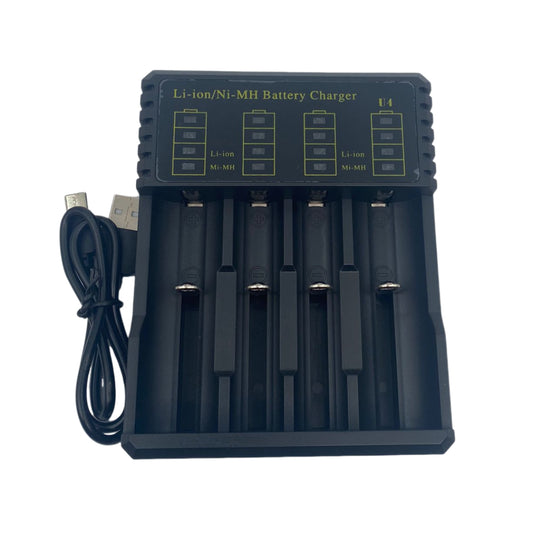-
공급업체:BATTERYINT
3.2V 15000mAh 33140 충전식 배터리 팩 Lifepo4 리튬 배터리
- 정가
- $14.68
- 정가
-
- 할인가
- $14.68
- 단가
- 단위
3.2V 15000mAh 33140 충전식 배터리 팩 Lifepo4 리튬 배터리 제품... -
공급업체:BATTERYINT
33140 3.2V 15000mAh LiFePO4 충전식 배터리 셀 - 백업 전원 및 플래시라이트용
- 정가
- $24.81
- 정가
-
- 할인가
- $24.81
- 단가
- 단위
33140 3.2V 15000mAh LiFePO4 충전식 배터리 셀 - 백업 전원 및... -
공급업체:BATTERYINT
12개입 3.2V 33140 15Ah 배터리 (DIY 4S 12V 24V 36V 48V 20Ah 30Ah 전동 자전거, 스쿠터, 전동 공구용)
- 정가
- $199.00
- 정가
-
- 할인가
- $199.00
- 단가
- 단위
12개입 3.2V 33140 15Ah 배터리 (DIY 4S 12V 24V 36V 48... -
공급업체:batteryzone-de
4개입 3.2V 33140 15Ah lifepo4 배터리 DIY 4S 12V 24V 36V 48V 20Ah 30Ah 전기자전거 전동스쿠터용
- 정가
- $89.99
- 정가
-
- 할인가
- $89.99
- 단가
- 단위
4개입 3.2V 33140 15Ah lifepo4 배터리 DIY 4S 12V 24V ...
표시 1 -4 의 4 항목
1. 33140 lifepo4 배터리란 무엇인가요?
33140 lifepo4 배터리는 직경 33mm, 높이 140mm의 충전식 리튬 철인산 배터리입니다. 높은 에너지 밀도, 뛰어난 안전 프로필, 긴 사이클 수명으로 유명하여 안정적이고 일관된 전력이 필요한 애플리케이션에 이상적입니다. 다른 리튬 이온 화학 물질과 비교했을 때, lifepo4 33140 셀은 과열 및 열 폭주에 더 안정적이고 강하기 때문에 고성능 애플리케이션에 자주 선택됩니다.
2. 33140 배터리의 주요 용도는 무엇입니까?
33140 배터리는 높은 에너지 출력과 긴 사이클 수명으로 인해 전기 자동차, 태양열 저장 장치, 전동 공구 등 다양한 산업에서 일반적으로 사용됩니다. 또한 비상 백업 시스템 및 휴대용 전원 솔루션과 같이 빈번한 충전 및 방전이 필요한 애플리케이션에도 적합합니다. LiFePO4 33140 배터리는 특히 소형 크기와 안정적인 화학 성분으로 인해 높은 전력 부하에서 내구성과 일관된 성능이 모두 필요한 프로젝트에 선호되는 선택입니다.
3. 33140 배터리는 얼마나 오래 지속되나요?
33140 배터리의 수명은 사용 방법에 따라 다를 수 있지만 일반적으로 이상적인 조건에서 2,000~3,000회 이상의 인상적인 사이클 수명을 제공합니다. 이 사이클 수명은 종종 약 500~1,000회 수명을 갖는 기존 리튬 이온 배터리보다 상당히 깁니다. 과충전 및 극한 온도를 피하는 것을 포함한 적절한 관리를 통해 lifepo4 33140 셀은 10년 이상 지속될 수 있어 장기 에너지 저장을 위한 비용 효율적인 솔루션이 됩니다.
4. 33140 리튬 배터리를 낮은 기온에서도 사용할 수 있나요?
예, 33140 리튬 배터리는 더 낮은 온도에서도 작동할 수 있지만, 매우 낮은 온도에서는 성능이 저하될 수 있습니다. 일반적으로 LiFePO4 33140 배터리는 -20°C(-4°F)와 같이 추운 환경에서도 효과적으로 작동할 수 있지만, 방전 속도가 느릴 수 있으며 전체 용량이 감소할 수 있습니다. 최적의 성능을 위해 권장 온도 범위 내에서 이러한 배터리를 사용하는 것이 가장 좋으며, 추운 환경에서 자주 사용하는 경우 배터리 가열 시스템을 통합하면 효율성을 유지하는 데 도움이 될 수 있습니다.
5. 33140 배터리를 실내에서 사용하기에 안전합니까?
33140 배터리는 가장 안전한 리튬 이온 배터리 유형 중 하나로 간주되며 적절하게 관리하면 실내에서 사용하기에 적합합니다. 다른 리튬 이온 화학 물질과 달리 LiFePO4 33140 배터리는 매우 안정적이고 과열되기 쉽지 않아 화재 및 폭발 위험을 줄입니다. 또한 이러한 배터리는 정상 작동 중에 유해 가스를 방출하지 않아 밀폐된 공간에 더 안전합니다. 그러나 극한 온도에 노출되는 것을 피하고 배터리를 가연성 물질에서 멀리하는 것을 포함하여 표준 배터리 안전 관행을 따르는 것이 여전히 필수적입니다.
6. 33140 lifepo4 배터리는 어떻게 충전하나요?
33140 lifepo4 배터리를 충전하는 것은 간단하지만, 최적의 성능과 안전을 보장하기 위해 LiFePO4 화학 물질에 맞게 특별히 설계된 충전기가 필요합니다. 이러한 충전기는 일반적으로 정전류/정전압(CC/CV) 충전 방법을 사용합니다. lifepo4 33140 셀을 충전하려면 적절한 충전기에 연결하고 완전히 충전되도록 하면 됩니다. 일반적으로 충전기의 출력과 배터리 용량에 따라 몇 시간이 걸립니다. LiFePO4 셀을 손상시킬 수 있으므로 다른 리튬 이온 배터리용 충전기를 사용하지 않는 것이 중요합니다.
7. 다른 유형에 비해 33140 lifepo4 배터리를 사용하는 주요 장점은 무엇입니까?
33140 배터리는 더 긴 사이클 수명, 향상된 열 안정성, 향상된 안전 기능을 포함한 여러 가지 장점이 있습니다. 기존의 리튬 이온 배터리와 달리 LiFePO4 33140 배터리는 열 폭주에 더 강하여 화재 위험을 줄입니다. 또한 이러한 배터리는 방전 곡선이 더 평평하여 방전 사이클 내내 더 일관된 전압을 유지하여 배터리가 거의 고갈될 때까지 안정적인 전력을 제공합니다. 심방전을 처리할 수 있는 능력은 빈번한 재충전이 필요한 애플리케이션에도 이상적입니다.
8. 33140 배터리를 직렬이나 병렬로 연결할 수 있나요?
네, 33140 LiFePO4 배터리는 전압 또는 용량을 각각 증가시키기 위해 직렬 또는 병렬로 연결할 수 있습니다. lifepo4 33140 셀을 직렬로 연결하면 전체 전압 출력이 증가하여 더 높은 전압이 필요한 애플리케이션에 유용하고, 병렬로 연결하면 용량이 증가하여 런타임이 더 길어집니다. 유사한 전압 및 용량 정격의 배터리를 사용하고 배터리 관리 시스템(BMS)을 통합하여 균형 잡힌 충전 및 방전을 보장하는 것이 필수적이며, 이는 배터리 팩의 전체 수명을 연장하는 데 도움이 됩니다.
9. 33140 배터리를 장기간 보관할 때 무엇을 고려해야 합니까?
33140 배터리를 장기간 보관할 때는 과방전이나 과충전을 방지하기 위해 50% 충전 상태로 유지하는 것이 가장 좋습니다. 과방전이나 과충전은 모두 배터리 수명을 단축시킬 수 있습니다. LiFePO4 33140 배터리는 직사광선이 들지 않는 시원하고 건조한 곳에 보관해야 합니다. 고온은 셀 열화를 가속화할 수 있기 때문입니다. 또한 몇 달마다 배터리를 점검하고 필요한 경우 충전하여 충전을 최적 수준으로 유지하는 것이 좋습니다. 적절한 보관 조건은 배터리 용량을 보존하고 사용 수명을 연장하는 데 도움이 될 수 있습니다.
10. 33140 배터리를 폐기하면 환경에 미치는 영향이 있습니까?
33140 유형을 포함한 LiFePO4 배터리는 일반적으로 코발트, 납 또는 카드뮴과 같은 유해한 중금속을 포함하지 않기 때문에 다른 리튬 이온 배터리에 비해 환경 친화적으로 간주됩니다. 그러나 lifepo4 33140 셀은 여전히 지정된 배터리 재활용 센터에서 적절하게 폐기하여 재료를 안전하게 회수하거나 중화할 수 있도록 해야 합니다. 가정용 쓰레기에 버리는 것과 같은 부적절한 폐기는 환경 오염으로 이어질 수 있으므로 배터리 폐기 및 재활용에 대한 지역 지침을 따르는 것이 중요합니다.





















